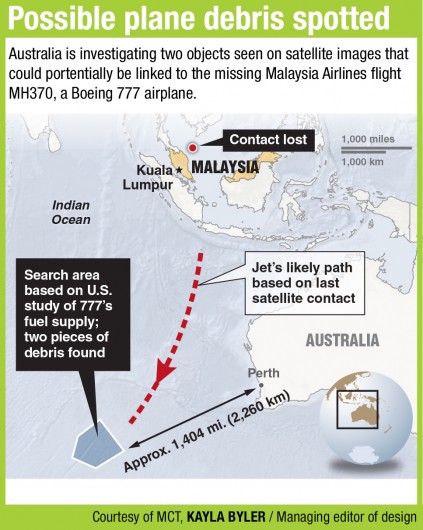After a flight disappeared more than two weeks ago halfway around the world, some faculty and staff at Ohio State said the search is like looking for a needle in a yet-to-be discovered haystack.
Malaysian Airlines Flight MH370 from Kuala Lumpur, Malaysia, to Beijing took off at 12:41 a.m. March 8 and then vanished from radars shortly after 1 a.m. It was scheduled to land at 6:30 a.m. and was carrying 227 passengers from 14 countries and 12 crew members. Some radars picked up signals from what was likely MH370 later in the night that showed it had flown away from its scheduled path, but as of Sunday evening, there was no complete theory as to where the plane had gone.
OSU’s Center for Aviation Studies director Seth Young put the size of the search into perspective.
“The area that the investigators are targeting on right now is an area about the size of the United States, and they started to focus on an area maybe the size of the Great Lakes region,” Young said. “We are looking for an aircraft when whole is only 200 feet long by 200 feet wide, and when broken up into pieces during a crash, these pieces could be as small as a piece of an upholstery seat.”
The United States’ area is about 3.72 million square feet, according to the United States Department of the Interior’s National Atlas, and the Great Lakes region covers 94,250 square miles of water area, according to the United States Environmental Protection Agency website.
Young said he doesn’t think there is evidence to support a terrorist-related theory.
“As an aviation safety person, what I try to do is gather evidence that would lead towards a certain determination, and at this point, I haven’t seen any evidence that points towards any malicious act,” Young said.
Young said an emergency or problem on the plane could have prompted the pilot to try to find a safe place to land.
“Because the plane was only about 35 minutes into its flight, sometimes the instinct of the pilot is to turn back home,” Young said.
Young said he believes there are airfields west of the plane’s initial location, which could have prompted the pilot to turn west rather than to continue going north and thus leading to its disappearance.
Shawn Pruchnicki, an OSU professor who teaches aviation safety, human factors, accident investigation and complex aircraft operation, said the disappearance could be because of mechanical issues.
“Sometimes what happens is when (lithium batteries) are jostled around or when they break, they can heat up and catch not only themselves, but the cargo pit catches on fire,” Pruchnicki said. “They’re really fast-moving, devastating fires that usually aircraft fire suppresser systems are not able to suppress.”
He said the batteries are sometimes transported in the cargo area of the plane.
Pruchnicki compared the disappearance to a 2010 UPS cargo jet crash, which allegedly was caused by a fire created by the transportation of flammable lithium batteries.
Along with incapacitating the pilots, Pruchnicki said a fire could damage the navigation system and leave the plane traveling in its current direction.
“If the navigation system fails, that airplane will maintain (the direction) its heading,” Pruchnicki said.
Young said the radar coverage around the area of Thailand, South China and India also has much less radar coverage than the United States, where airplanes are under constant surveillance.
Bad weather conditions have also created problems in searching for the plane, and Pruchnicki said the rough waters can create visibility problems.
“It’s not like you’re cruising along at 5,000 feet and you look out and you can see 20 miles all around you and you would notice a seat cushion or debris. That’s really hard to see small items like that, especially in rough seas,” Pruchnicki said.
The search has been using satellite images and planes, among other means.
The rough weather, including high winds, can also allow for possible plane wreckage pieces to be scattered further throughout the ocean, Pruchnicki said.
Jailyn Soto-Quintana, a third-year in political science, said the disappearance worries her.
“People don’t just disappear. This isn’t a movie, this isn’t a fairy tale,” Soto-Quintana said. “(The disappearance) is a huge deal. We should know where these people are and why they are gone.”
Jeremy Jett, a third-year in international studies, said the airplane’s disappearance doesn’t surprise him that much.
“It’s definitely unusual. If all the GPS systems were turned off, we don’t have satellites dedicated to tracking planes, so it’s definitely unusual but it’s not crazy,” Jett said.
While airplanes have disappeared in the past, Young said there are improvements that could be made to prevent similar situations from happening in the future.
“The proliferation of a 21st century technology to monitor the movement of aircraft is something that could definitely help,” Young said.
Pruchnicki said for now, no theories can be ruled out in the disappearance of flight MH370.
“It’s not like looking for a needle in the haystack, it’s like looking for a needle in Nebraska. We haven’t even found the haystack yet,” Pruchnicki said.



